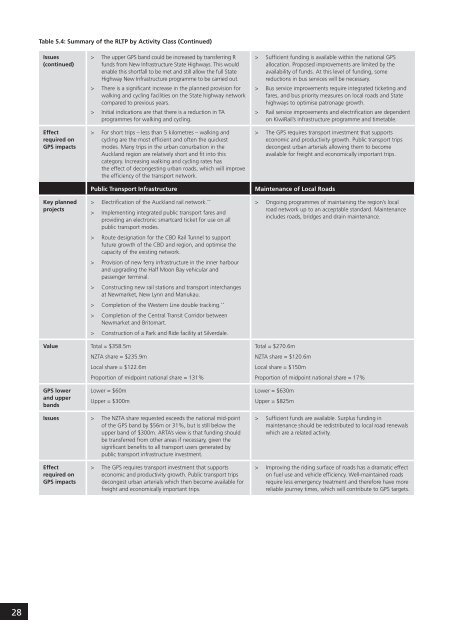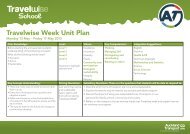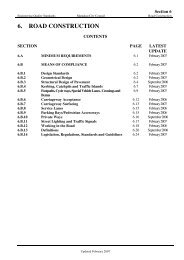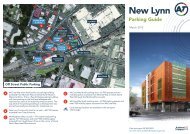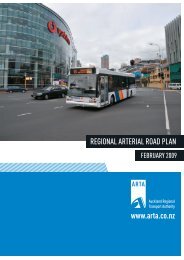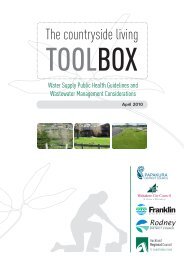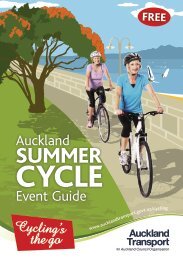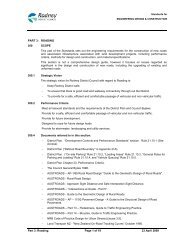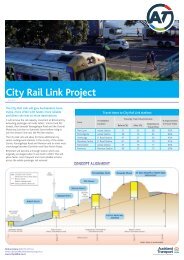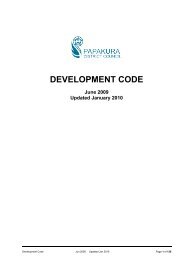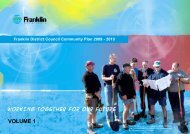Regional Land Transport Programme 2009 - 2010 (2MB) - Auckland ...
Regional Land Transport Programme 2009 - 2010 (2MB) - Auckland ...
Regional Land Transport Programme 2009 - 2010 (2MB) - Auckland ...
You also want an ePaper? Increase the reach of your titles
YUMPU automatically turns print PDFs into web optimized ePapers that Google loves.
Table 5.4: Summary of the RLTP by Activity Class (Continued)<br />
Issues<br />
(continued)<br />
><br />
><br />
><br />
The upper GPS band could be increased by transferring R<br />
funds from New Infrastructure State Highways. This would<br />
enable this shortfall to be met and still allow the full State<br />
Highway New Infrastructure programme to be carried out.<br />
There is a significant increase in the planned provision for<br />
walking and cycling facilities on the State highway network<br />
compared to previous years.<br />
Initial indications are that there is a reduction in TA<br />
programmes for walking and cycling.<br />
><br />
><br />
><br />
Sufficient funding is available within the national GPS<br />
allocation. Proposed improvements are limited by the<br />
availability of funds. At this level of funding, some<br />
reductions in bus services will be necessary.<br />
Bus service improvements require integrated ticketing and<br />
fares, and bus priority measures on local roads and State<br />
highways to optimise patronage growth.<br />
Rail service improvements and electrification are dependent<br />
on KiwiRail’s infrastructure programme and timetable.<br />
Effect<br />
required on<br />
GPS impacts<br />
> For short trips – less than 5 kilometres – walking and<br />
cycling are the most efficient and often the quickest<br />
modes. Many trips in the urban conurbation in the<br />
<strong>Auckland</strong> region are relatively short and fit into this<br />
category. Increasing walking and cycling rates has<br />
the effect of decongesting urban roads, which will improve<br />
the efficiency of the transport network.<br />
> The GPS requires transport investment that supports<br />
economic and productivity growth. Public transport trips<br />
decongest urban arterials allowing them to become<br />
available for freight and economically important trips.<br />
Public <strong>Transport</strong> Infrastructure<br />
Maintenance of Local Roads<br />
Key planned<br />
projects<br />
><br />
><br />
Electrification of the <strong>Auckland</strong> rail network. **<br />
Implementing integrated public transport fares and<br />
providing an electronic smartcard ticket for use on all<br />
public transport modes.<br />
><br />
Ongoing programmes of maintaining the region’s local<br />
road network up to an acceptable standard. Maintenance<br />
includes roads, bridges and drain maintenance.<br />
><br />
Route designation for the CBD Rail Tunnel to support<br />
future growth of the CBD and region, and optimise the<br />
capacity of the existing network.<br />
><br />
Provision of new ferry infrastructure in the inner harbour<br />
and upgrading the Half Moon Bay vehicular and<br />
passenger terminal.<br />
><br />
Constructing new rail stations and transport interchanges<br />
at Newmarket, New Lynn and Manukau.<br />
><br />
Completion of the Western Line double tracking. **<br />
><br />
Completion of the Central Transit Corridor between<br />
Newmarket and Britomart.<br />
><br />
Construction of a Park and Ride facility at Silverdale.<br />
Value<br />
GPS lower<br />
and upper<br />
bands<br />
Total = $358.5m<br />
NZTA share = $235.9m<br />
Local share = $122.6m<br />
Proportion of midpoint national share = 131%<br />
Lower = $60m<br />
Upper = $300m<br />
Total = $270.6m<br />
NZTA share = $120.6m<br />
Local share = $150m<br />
Proportion of midpoint national share = 17%<br />
Lower = $630m<br />
Upper = $825m<br />
Issues<br />
Effect<br />
required on<br />
GPS impacts<br />
> The NZTA share requested exceeds the national mid-point<br />
of the GPS band by $56m or 31%, but is still below the<br />
upper band of $300m. ARTA’s view is that funding should<br />
be transferred from other areas if necessary, given the<br />
significant benefits to all transport users generated by<br />
public transport infrastructure investment.<br />
> Sufficient funds are available. Surplus funding in<br />
maintenance should be redistributed to local road renewals<br />
which are a related activity.<br />
> The GPS requires transport investment that supports<br />
economic and productivity growth. Public transport trips<br />
decongest urban arterials which then become available for<br />
freight and economically important trips.<br />
> Improving the riding surface of roads has a dramatic effect<br />
on fuel use and vehicle efficiency. Well-maintained roads<br />
require less emergency treatment and therefore have more<br />
reliable journey times, which will contribute to GPS targets.<br />
28


